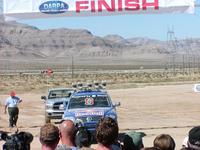Stanford Team Clinches Top Spot in Robot Desert Race
Stanley, the Stanford Racing Team's entry in the DARPA Grand Challenge, has finished first, earning the team a $2 million prize. The Oct. 8 off-road race pitted 23 autonomous vehicles against each other on a 132-mile desert course that began and ended in Primm, Nev. Only five vehicles made it through the course. With a finish time of 6:53, the Stanford Racing Team beat Carnegie Mellon's Red Team (7:04) and Red Team Too (7:14), The Gray Insurance Company's Gray Team (7:30) and Team TerraMax (12:51).
PRIMM, Nevada October 10, 2005; Reed Stevenson writing for Reuters reported that a Stanford University team won a $2 million prize on Sunday for sending a modified Volkswagen across 132 miles of rugged desert, guided only by sensors and computers in a race the Pentagon hopes will lead to a technological breakthrough in warfare.
Twenty-three driverless vehicles were sent into the Mojave Desert on Saturday in a race sponsored by the Pentagon's Defense Advanced Research Projects Agency, known as DARPA.
After extending the race a day to allow a slow-moving robotic vehicle to finish, the Stanford University vehicle, known as Stanley, was declared the winner of the Grand Challenge with the quickest race time of six hours and 54 minutes.
Sebastian Thrun, leader of the Stanford team, said the victory was a win for the automobile's future, predicting that all cars would one day be able to drive themselves.
DARPA sponsored the race to spur development of driverless vehicles that one day could carry water, fuel and other supplies for the U.S. military in war zones.
In last year's inaugural race, called the Grand Challenge, every machine failed within sight of the starting line. The Pentagon decided to double the prize and hold the event again this year.
Organizers designed a more difficult course this year and an assortment of modified Humvees, sports utility vehicles, pickup trucks and dune buggies were sent into the mountains and valleys in the Mojave to navigate man-made obstacles, tunnels and a dry lake bed.
"These vehicles just haven't achieved world records, they've made history," said DARPA director Tony Tether.
One broke down at the starting line and 17 others stopped moving at various points on the course.
Four made it back to the finish line to complete the race and one, a huge six-wheeled truck called TerraMax, was stopped overnight so it could make it to the finish line.
Coming in just after Stanley were a pair of modified Humvees built by a Carnegie Mellon University team. A modified sports utility vehicle called GrayBot also finished just after sunset on Saturday. The rugged, twisting course, about 40 miles southwest of Las Vegas on the Nevada-California border, was chosen because of its similarity to terrain where the U.S. military is currently most active, Iraq and the Middle East.
At one point, the vehicles had to climb through a steep valley that organizers said was "reminiscent of a mountain pass in Afghanistan."
Using global positioning satellites and inertial navigation, the vehicles were programmed to follow a pre-defined course disclosed only hours before the race. Radar, lasers and cameras mounted on the vehicles guided onboard computers that steered the vehicles around obstacles.



